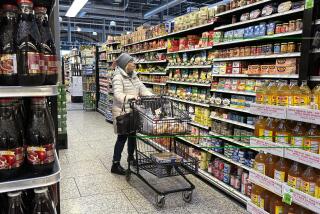Economy expands at solid 3.2% annual rate in fourth quarter
WASHINGTON — U.S. consumer spending ended last year with a flourish, lifting overall economic growth and renewing hopes that the recovery will hit its stride this year and boost employment and incomes.
The economy expanded at a solid 3.2% annual rate in the fourth quarter, the government estimated Thursday. Figures showed that people ate out more and bought more cars, clothes and other goods and services. Rising exports and a rebound in business spending for equipment also helped.
Growth was “pretty impressive,” especially after taking into account the nearly three-week partial federal government shutdown at the start of October, said Paul Ashworth, an economist at Capital Economics.
The Commerce Department estimated that the government shutdown clipped 0.3 of a percentage point from growth in the fourth quarter. Without that hit and other federal spending cuts, fourth-quarter growth would have matched the third-quarter rate of 4.1%.
The drag from higher taxes and budget spending reductions enacted last year has largely receded, to the point where analysts believe that the government sector will have a neutral effect on overall economic growth going forward.
That means consumer spending and business investment will write the economic recovery story this year, and the fourth-quarter data suggested that at least there was good momentum heading into this year.
Personal spending, which accounts for more than two-thirds of U.S. economic activity, accelerated 3.3% in the final three months of last year — the fastest pace in three years.
“It’s very encouraging,” said Shawn DuBravac, chief economist for the Consumer Electronics Assn.
Investors also were buoyed by fresh evidence in the report that the U.S. economy was strong enough to advance without the Federal Reserve’s stimulus. Fed policymakers moved Wednesday to further reduce their bond-buying stimulus, affirming confidence that the economy and job market would continue to improve.
“It’s just another step in the right direction,” Joe Bell, senior equity analyst with Schaeffer’s Investment Research, said about the fourth-quarter growth. “Most people are looking for good economic news because they’re wanting to see if this market or if this economy can stand on its own two feet.”
Wall Street also was cheered by promising news from the corporate world. Facebook Inc., Viacom Inc. and Visa Inc. all reported fourth-quarter earnings that beat Wall Street analysts’ expectations.
The Dow Jones industrial average gained 109.82 points, or 0.7%, to 15,848.61. The broader Standard & Poor’s 500 index gained 19.98 points, or 1.1%, to 1,794.19. And the technology-focused Nasdaq composite index gained 71.69, or 1.8%, to 4,123.13.
Even so, the Dow was still off 4.4% for the year. Stocks have had a rocky January with investors anxious about the growth potential in developing countries as the Fed scales back on the money it pumps into the global economy.
For the year, the economy expanded at a more modest 1.9% annual rate, down from 2.8% in 2012. But the slowdown in the gross domestic product — the value of all goods and services produced — came mainly from weakness early last year.
More worrisome is the prospect of a slowdown in China, the world’s second-largest economy and an important driver of growth in major emerging economies such as those in Brazil and South Africa.
If China slows and currencies in emerging markets continue to tumble against the dollar, U.S. exports and the profits of multinational companies that sell products in those countries could drop.
Either way, trade isn’t expected to provide such a big boost to the economy as it did in the fourth quarter. American companies last quarter also continued to build up inventory, which could weigh on future production and growth if sales don’t keep up.
That leaves business investment and hiring, which have lagged behind given their strong profits and stockpiles of cash.
Company spending for equipment rose 6.9% in the final three months of last year, the most in a year. But beneath the surface, the number was less impressive. The step-up in spending was driven largely by farm transportation and other purchases by companies moving to lock in tax credits before year’s end, said Mark Zandi, chief economist at Moody’s Analytics.
Business leaders, though, remained confident, Zandi said. His firm’s reading of such company sentiments reached its highest level this month since the survey began in 2003.
“It took off after the government reopened in October,” he said. “But it’s not shown up in business investment yet. We need to see businesses ramp it up here.”
Another soft spot in the fourth quarter was housing investment, which dropped for the first time in more than three years. Most analysts expect a rebound this year as home-building perks up and housing prices continue to rise.
Analysts said the cold weather probably had a role in last month’s drop in housing investment, but a rise in long-term interest rates in the second half of last year also contributed, underscoring one of the biggest risks for the U.S. economy.
Zandi said he expected the Fed to manage a gradual increase in interest rates as the economy strengthens. So long as the broader economy improves and gains in hiring and incomes follow, he said, the higher rates shouldn’t stymie consumer spending.
“What matters are jobs,” he said.
Lee reported from Washington and Tangle from New York.







